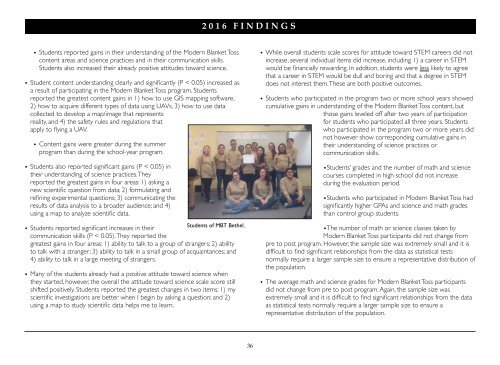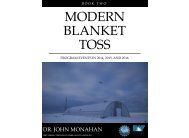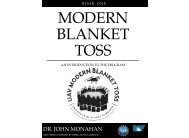Modern Blanket Toss: Findings and Observations
This book is the last in a series of three covering the National Science Foundation awarded Modern Blanket Toss project. In this book are the evaluation findings for each of the three years as well as observations from Modern Blanket Toss staff.
This book is the last in a series of three covering the National Science Foundation awarded Modern Blanket Toss project. In this book are the evaluation findings for each of the three years as well as observations from Modern Blanket Toss staff.
Create successful ePaper yourself
Turn your PDF publications into a flip-book with our unique Google optimized e-Paper software.
2016 FINDINGS<br />
• Students reported gains in their underst<strong>and</strong>ing of the <strong>Modern</strong> <strong>Blanket</strong> <strong>Toss</strong><br />
content areas <strong>and</strong> science practices <strong>and</strong> in their communication skills.<br />
Students also increased their already positive attitudes toward science.<br />
• Student content underst<strong>and</strong>ing clearly <strong>and</strong> significantly (P < 0.05) increased as<br />
a result of participating in the <strong>Modern</strong> <strong>Blanket</strong> <strong>Toss</strong> program. Students<br />
reported the greatest content gains in 1) how to use GIS mapping software,<br />
2) how to acquire different types of data using UAVs, 3) how to use data<br />
collected to develop a map/image that represents<br />
reality, <strong>and</strong> 4) the safety rules <strong>and</strong> regulations that<br />
apply to flying a UAV.<br />
• Content gains were greater during the summer<br />
program than during the school-year program.<br />
• Students also reported significant gains (P < 0.05) in<br />
their underst<strong>and</strong>ing of science practices. They<br />
reported the greatest gains in four areas: 1) asking a<br />
new scientific question from data; 2) formulating <strong>and</strong><br />
refining experimental questions; 3) communicating the<br />
results of data analysis to a broader audience; <strong>and</strong> 4)<br />
using a map to analyze scientific data.<br />
• Students reported significant increases in their<br />
Students of MBT Bethel.<br />
communication skills (P < 0.05). They reported the<br />
greatest gains in four areas: 1) ability to talk to a group of strangers; 2) ability<br />
to talk with a stranger; 3) ability to talk in a small group of acquaintances; <strong>and</strong><br />
4) ability to talk in a large meeting of strangers.<br />
• Many of the students already had a positive attitude toward science when<br />
they started, however, the overall the attitude toward science scale score still<br />
shifted positively. Students reported the greatest changes in two items: 1) my<br />
scientific investigations are better when I begin by asking a question; <strong>and</strong> 2)<br />
using a map to study scientific data helps me to learn.<br />
• While overall students scale scores for attitude toward STEM careers did not<br />
increase, several individual items did increase, including 1) a career in STEM<br />
would be financially rewarding. In addition, students were less likely to agree<br />
that a career in STEM would be dull <strong>and</strong> boring <strong>and</strong> that a degree in STEM<br />
does not interest them. These are both positive outcomes.<br />
• Students who participated in the program two or more school years showed<br />
cumulative gains in underst<strong>and</strong>ing of the <strong>Modern</strong> <strong>Blanket</strong> <strong>Toss</strong> content, but<br />
those gains leveled off after two years of participation<br />
for students who participated all three years. Students<br />
who participated in the program two or more years did<br />
not however show corresponding cumulative gains in<br />
their underst<strong>and</strong>ing of science practices or<br />
communication skills.<br />
•Students’ grades <strong>and</strong> the number of math <strong>and</strong> science<br />
courses completed in high school did not increase<br />
during the evaluation period.<br />
•Students who participated in <strong>Modern</strong> <strong>Blanket</strong> <strong>Toss</strong> had<br />
significantly higher GPAs <strong>and</strong> science <strong>and</strong> math grades<br />
than control group students.<br />
•The number of math or science classes taken by<br />
<strong>Modern</strong> <strong>Blanket</strong> <strong>Toss</strong> participants did not change from<br />
pre to post program. However, the sample size was extremely small <strong>and</strong> it is<br />
difficult to find significant relationships from the data as statistical tests<br />
normally require a larger sample size to ensure a representative distribution of<br />
the population.<br />
• The average math <strong>and</strong> science grades for <strong>Modern</strong> <strong>Blanket</strong> <strong>Toss</strong> participants<br />
did not change from pre to post program. Again, the sample size was<br />
extremely small <strong>and</strong> it is difficult to find significant relationships from the data<br />
as statistical tests normally require a larger sample size to ensure a<br />
representative distribution of the population.<br />
36




